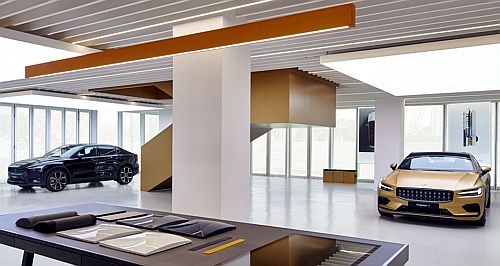Make / Model Search
News - PolestarHybrid Polestars ruled out amid BEV retreatPolestar doubles down on BEV commitment while key rivals reverse ambitious targets14 Jul 2025 By TOM BAKER POLESTAR has reaffirmed its exclusive focus on battery electric vehicles (BEVs), distancing itself from decisions by premium peer brands – including Mercedes-Benz, Audi, Porsche and former parent Volvo – to backtrack on ambitious timelines to phase out internal combustion engine (ICE) technologies.
The Gothenburg, Sweden-based marque owned by Geely Automotive Holdings (GAH) remains one of only a few brands that is steadfastly maintaining its commitment to pure-electric powertrains at a time when hybrid (HEV) and plug-in hybrid (PHEV) adoption is surging in various markets, including Australia.
While Volvo, Mercedes-Benz, and Audi have all revised or delayed plans to eliminate ICE and hybridised drivetrains in favour of BEVs, Polestar executives have reiterated that the brand has no intention of following suit.
The Australian arm of Polestar has never sold a combustion-powered model, despite the firm’s global debut model as a standalone operation – the limited-run Polestar 1 – being a PHEV offering both a turbo-petrol engine and extensive electric range (124km WLTP).
Production of the Polestar 1 ended in 2022, and since then, the brand’s offerings (manufactured in China, South Korea and the United States) have been BEV-only atop a mix of dedicated electric platforms or heavily revised ICE underpinnings sourced from Volvo.
That trend will continue when production of the brand’s most important model yet commences in late 2027 in Slovakia. The Polestar 7, a small premium SUV, will be the brand’s first European-built model, and it will be offered only with electric power with no PHEV or HEV powertrain planned.
Polestar Australia managing director Scott Maynard told GoAuto that the company remains resolute in its BEV-only strategy, noting that the brand sees differentiation in its unwillingness to bend – and by stubbornly refusing to blend ICE and EV in its retail outlets.
“I’m personally chuffed that our CEO (Gothenburg-based Michael Lohscheller) has doubled down on saying we will be an EV-only brand, and that it is not a time to explore hybrid technology,” Mr Maynard said.
“I think there is a market for a brand that specialises in EV and does not continue to try and put an EV skateboard under an ICE chassis. I think that works well for us.”
Polestar’s steadfastness on producing only BEVs is echoed by Tesla, which makes only electrics. Tesla briefly entertained the idea of conjoining a petrol-powered range extender to its US-market Cybertruck ute but abandoned the plan in favour of introducing longer-range versions of the pick-up.
While legacy rivals like Mercedes-Benz and Audi have pushed back BEV-only sales targets from 2030 and 2033 respectively, some brands that initially held aspirations of selling only BEVs in Australia – including China’s BYD – have introduced PHEVs in recent times with significant sales success.
Mr Maynard’s comments reflect the sentiment of Mr Lohscheller, who wrote in a 2024 open latter that “indecisiveness (not) only slows down the green transition (but) also ensures that brown alternatives remain the cheaper and more convenient alternative” for car buyers.
Polestar’s current product range globally and in Australia comprises the Polestar 2 sedan, which shares its CMA platform with the Volvo XC40 (HEV/PHEV) and EX40 (BEV); the Polestar 3 large SUV (twinned to the Volvo EX90 BEV); and the Polestar 4 coupe-SUV, which shares its SEA EV platform with GAH cousins.
The next release, the Polestar 5 super-sedan, utilises a bespoke aluminium architecture for BEVs designed in-house.
Long driving range has been a focus for Polestar as it seeks to overcome buyer concerns about real-world BEV practicality.
Presently, the Polestar 2 Standard Range variant offers the shortest range in the line-up at (a considerable) 520km WLTP, while the Polestar 3 Single Motor has the longest range at 706km.
While global BEV sales expanded by 25 per cent in 2024, exceeding 20 per cent of total new car sales for the first time (largely due to Chinese BEV demand), some manufacturers have responded to softening BEV demand growth in Western markets by slowing electrification plans.
In Australia in the first half of 2025, BEVs comprised about eight per cent of new car deliveries, with that figure being similar to the same result in 2024 despite continuing federal government support for BEV purchases via a full exemption from fringe benefit tax (FBT) for leasing customers.
Meanwhile, hybrid drivetrains – particularly PHEVs – have seen marked increases in local demand. PHEVs now account for roughly four per cent of Australian new car sales, while conventional hybrids (without a plug) sit at around 16 percent and pure ICE vehicles at about 72 per cent.
The strongest uplift in powertrain types this year in Australia has been PHEV, which have banked a huge 210 percent lift in sales across the first half of 2025 led by the BYD Shark 6 ute (10,424 deliveries) and BYD Sealion 6 medium SUV (4375), with both models built only in PHEV form.
Meanwhile, Polestar has sold 1173 models across each of its lines in Australia in the first six months of this year. Tesla managed a total of 14,156 deliveries in the same period.
Hybrids – whether or not they have a plug – are forecast to play a bigger role in the Australian vehicle mix as OEMs phase out pure ICE models for lower-CO2 alternatives in order to comply with the New Vehicle Efficiency Standard (NVES). Financial NVES penalties kicked in for OEMs on 1 July 2025.
Within GAH, several brands have embraced expanded hybrid strategies. Volvo has lengthened the lifespan of its XC90 and XC60 SUVs (with a choice of mild hybrid and PHEV options) alongside electric siblings in the EX90 and forthcoming EX60, while Zeekr and Geely will soon introduce PHEVs to Australia.  Read more |
Click to sharePolestar articlesMotor industry news |












Facebook Twitter Instagram